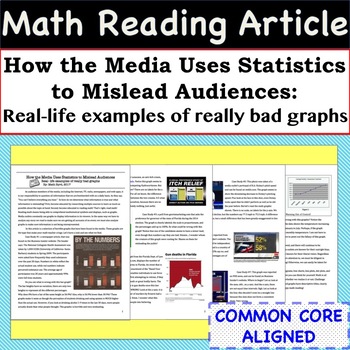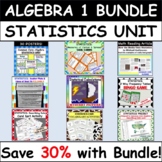Statistics Math Article - Case Studies of Bad Graphs found in the Media
Also included in
- Incorporate Reading & Writing into the Math Classroom with this bundle set of MATH READING ARTICLES designed to accommodate the Common Core Algebra 1 class. There are 4 sets of math reading articles:1) "Linear Equation Applications for Life"2) "6 Ways Quadratics Are Used Everyday in the World"3)Price $14.77Original Price $21.10Save $6.33
- This Statistics Unit Bundle set includes a wide variety of 10 resources all geared towards the Common Core Algebra 1 course.Resources Included:Culminating Project Based on Real World Data30 PostersCard Sort ActivityMath Reading Article & Follow Up SummaryTask Cards ActivityFoldableMystery ColorPrice $36.33Original Price $51.90Save $15.57
- The Common Core Algebra 1: Curriculum Set includes 59 differentiated resources and learning activities designed to engage students. The curriculum set is aligned to the Common Core standards which are outlined in the lesson plans for each resource. The Ultimate package for projects, vocabulary activPrice $213.36Original Price $304.80Save $91.44
Description
Incorporate Reading & Writing into the Math Classroom with this article and accompanying worksheet! The 4 page article is entitled - "How the Media Uses Statistics to Mislead Audiences: Real- life examples of really bad graphs". The worksheet helps students summarize the case studies and the article as a whole. This resource can be used in so many ways, some ideas are: station activity, independent reading assignment, small group activity, homework assignment, or whole class discussion.
Skills Used:
Students will read the math article filled with erroneous statistical displays, including: bar graphs, line graphs, scatter plots. Students will analyze the characteristics of each graphic including axes, scales, descriptive titles, and precision.
Common Core Standards:
CCSS.MATH.PRACTICE.MP6 Attend to precision.
CCSS.HSS.ID.A.1 Represent data with plots on the real number line (dot plots, histograms, and box plots).
CCSS.HSS.ID.B.6 Represent data on two quantitative variables on a scatter plot, and describe how the variables are related.
CCSS.HSS.ID.B.6c Using given or collected bivariate data, fit a linear function for a scatter plot that suggests a linear association.
CCSS.HSS.ID.C.7 Interpret the slope (rate of change) and the intercept (constant term) of a linear model in the context of the data.
See similar resources:
Statistics: Representing and Interpreting Data(Box Plots, Histograms, Dot Plots) CARD SORT
Statistics: 2 Way Frequency Tables BINGO GAME
Statistics:Measures of Center and Spread TASK CARDS
Statistics: Scatter Plots and Lines of Best Fit FOLDABLE
Statistics Project: U.S. Home Energy & Tax Themed Analysis of Real-World Data
Statistics: Vocabulary Activities
Statistics: Line of Best Fit MYSTERY ACTIVITY (FREE!)
This topic is also covered in:
Algebra State Exam Prep: Study Guide w/ Notes and 2 Practice Tests
Algebra Warm-ups/ Bellringers/ Exit Tickets- COMMON CORE ALIGNED
Algebra Curriculum Vocabulary Bundle: Matching Card Sets & Vocabulary Puzzles
Common Core Algebra 1 Full Curriculum POSTERS
*Purchase of this product provides one (1) purchaser the rights for solely personal classroom use. Posting any part of this publication on the Internet in any form, including classroom websites, is strictly prohibited and in violation of the Digital Millennium Copyright Act. To share this resource with colleagues, please purchase additional licenses. Inquire to mathbyrd@gmail.com for discounted multiple license purchases.








